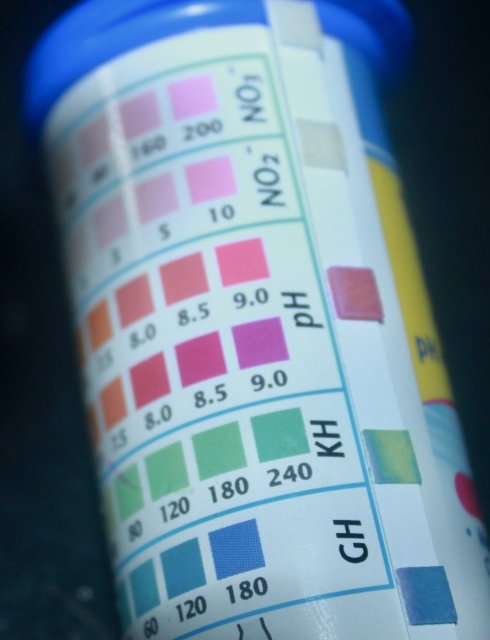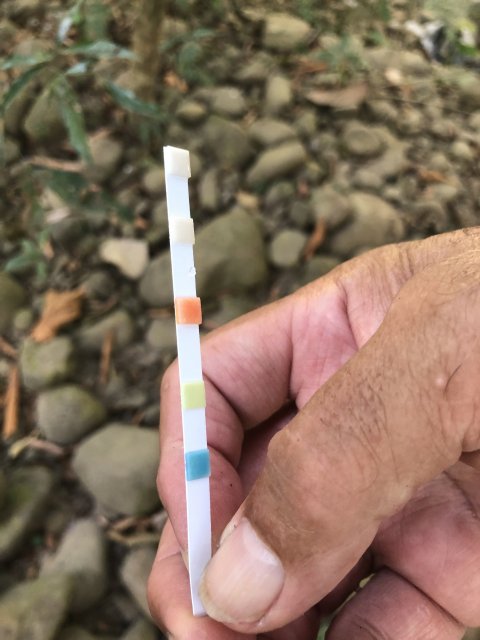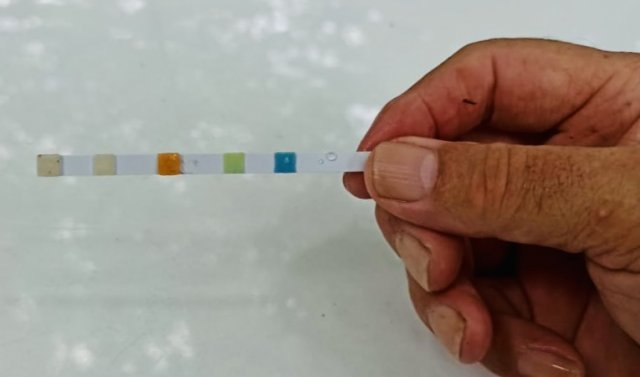Thorichthys meeki. Out of allllll the fish I have access to and on hand in my facility this is the species I keep at home! One of my personal favorites(obviously) and believe it or not the OP's issue is SUPER common with the species.
I'll start with a bit of a vendor rant and then segue into some useable information lol.
I read literally hundreds of emails a week from customers. Did you know that EVERYONE has "perfect water parameters"? No one ever, ever, has bad or more importantly the incorrect water parameters. Did you also know that EVERYONE has a quarantine tank and its a proper quarantine tank. And EVERYONE has been "doing this for decades". Literally everyone! of course, yes, as you may suspect I am being a little facetious but I read this in email weekly.
but I read this in email weekly.
So lets address it. Water parameters are perfect. Okay, and as Duane mentioned above, perfect for what? The particular mix of species in the OP's tank all require different parameters long term. T. meeki and the tetras are considered cooler water speceis and the severum and keyhole are warm, soft water fish. I know, I know, the internet experts have told you most fish are captive bred and are adapted to regular water. Not really true. We cannot alter a species morphology in just a few generations of captive breeding for them to be able to 'adjust'. Example, a soft, blackwater species, like a parrot cichlid(Hoplarchus psittacus, altum angel, Heros severus, etc will never be able to handle hard, high pH, high tds water long term. Thousands of years of morphology will not change because someone bred it at home. The species' internal organs simply are incapable of handling this. Sure, short term, and I mean up to several years as short term, they can be okay but ultimately the organs will fail and we see lateral line and sensory gland erosion. Often confused as a flagellate parasite the presumed suspect for HITH . When in fact the fish will have no parasites at all. Just the body shutting down and literally eating itself. These same fish have no natural immunities to bacterias that naturally exist in higher ph, harder water. Remember those blackwater species live in low ph, acidic water where bacterias have a hard time establishing. Ever try to cycle a tank with a ph of 5 or lower. Its a PITA. Then we have the temperature thing as part of a tanks parameters. Thorichthys are a 'cool' water genus. Not cold, but cool. I keep them unheated. Room temp is plenty warm for them. Has any reader here ever been to Cancun? it hot! but, ever jump into the cenotes for a swim. They are not hot. Most of them are cool, underground spring fed pools. Like a home swimming pool, surface temps may be warm but its cold down by your feet in the deep water. In an aquarium mid 60s to lower 70s is ideal for most Thorichthys. Anything over 75 for more than a few months typically will heat stress them over time. . Check the temperature
T. meeki, a species naturally out of cool, high pH, very hard liquid lime water, with even some salinity. Think rift lake cichlids(minus the temperature). It is best to keep them in cooler, harder water. Though, contrary to soft water species, while meeki will do best in the just mentioned parameters meeki are one of the ones that can do well in soft water providing all else is good. Thoricthys as a whole do not tolerate nitrates very well so check that as well.
This is also a shoaling fish. They do best in groups. Dare I say it.. almost over crowded. Thorichthys prefer more of themselves. They are a surprisingly delicate species that are prone to stressing out easily and rapidly. Heat, I have found is the biggest killer. Nearly all Central American cichlids do not need or even tolerate long term temps over 80. low to mid 70s is ideal to keep them happy AND still be able enjoy species from other regions of the world. In a CA only tank, upper 60s to mid 70s is perfect. You will be amazed to see how much 3-4 degrees changes an outcome long term.
As far as quarantining them. We aren't only quarantining them for what the new fish may have arrived with but also what the fish in an existing tank may be carriers of. If you've ever traveled out of the US to Asia, Africa, or parts of SA then you would be familiar with the inoculations required. For two reason, 1: so we don't pass diseases we my have to those never exposed to them and 2: well, vise versa. What we may be immune to, or others are immune to is not the same. SAME THING WITH FISH! Just because your fish look healthy does not mean they are not carriers of something that is waiting for a new host to arrive and infect. So when quarantining the fish we need to not only focus on the new arrivals but also treat the 'home team' at the same time so both are clean upon introduction. If your new fish arrived clean but a week or a few days later they have ich... it was probably your pre-existing fish gifting them with a new host.
As a vendor who sees or reads "I'm setting up my quarantine tank this weekend so I can receive the order next week". This kills me. How is that ever going to be a SOLID true quarantine tank. IMO, most(not all) hobbyists are stressing the fish more in the quarantine tank than if they just introduced them to the tank they are going to be in. Its a fine line though, because we certainly do not want to just introduce newly sourced animals to pre-existing livestock. If you use a separate quarantine tank, and you should!, than make sure it is an established tank that is a near copy of the future home tank. Often i see them and they are bare, tanks with a light on top and the fish are super stressed. the qt tank should mimic a safe place. Not an over sanitized hospital 'white room'.
As a USDA certified clean facility, a requirement I need in order to export overseas and to be a source for the public zoos, museums, and public aquariums i supply livestock to. I can tell you that every fish brought into my facility goes through a prophylactic medicinal treatment. They are covered for the basic, most common ailments. However, they can still stress out just from being handled and like people, some just do not travel well. Then of course we factor in how and where they are going during transit. From NNJ if I ship to Southern CA. the fish will go from currently warm NJ to cold Chicago for an overnight stay, to Warm CA i in the morning. Sure they are in a sealed box with proper packing but the ambient temps effect the inside of the box and how hard or not the heat packs need to work. The hot dark brown or freezing ups truck, and how many times was the box kicked, dropped, or 100% tossed. How long was it on a loading dock or tarmac in the blazing sun or frigid cold. These all affect the animals health at arrival and how well they will adjust to the new tank.
Another consideration when starting the quarantine is the initial acclimation. Are you floating and letting loose? Are you using the drip method? me, personally am against the drip method (see my reasons here:https://www.tangledupincichlids.com/acclimation) and as a professional I do not recommend it OR use it in my facility when new fish arrive here. Regardless of if wild of tank bred. I think we can honestly agree that I acclimate more fish than most anyone on here will or as ever done in a lifetime. I literally acclimate thousands of fish a month. One import contains a minimum of a 1,000 fish and that's a very small import. So, Ive seen it all and starting the acclimation correctly can increase survival in quarantine 10 fold.
Diet, meeki are carnivores ingesting plant matter only while picking for main food sources. They also pick all day. Not typically a fat bellied species. So feed lightly and less often. I find they do best with micro pellets and just flakes. Less is more!
Check your temp. Lower it enough to make the Thorichthys happy while being in the safe zone for the SA species you have.
Watch nitrates. They hate them.
Feed less.
Add more meeki! they love to be around other meeki.
I'll start with a bit of a vendor rant and then segue into some useable information lol.
I read literally hundreds of emails a week from customers. Did you know that EVERYONE has "perfect water parameters"? No one ever, ever, has bad or more importantly the incorrect water parameters. Did you also know that EVERYONE has a quarantine tank and its a proper quarantine tank. And EVERYONE has been "doing this for decades". Literally everyone! of course, yes, as you may suspect I am being a little facetious
So lets address it. Water parameters are perfect. Okay, and as Duane mentioned above, perfect for what? The particular mix of species in the OP's tank all require different parameters long term. T. meeki and the tetras are considered cooler water speceis and the severum and keyhole are warm, soft water fish. I know, I know, the internet experts have told you most fish are captive bred and are adapted to regular water. Not really true. We cannot alter a species morphology in just a few generations of captive breeding for them to be able to 'adjust'. Example, a soft, blackwater species, like a parrot cichlid(Hoplarchus psittacus, altum angel, Heros severus, etc will never be able to handle hard, high pH, high tds water long term. Thousands of years of morphology will not change because someone bred it at home. The species' internal organs simply are incapable of handling this. Sure, short term, and I mean up to several years as short term, they can be okay but ultimately the organs will fail and we see lateral line and sensory gland erosion. Often confused as a flagellate parasite the presumed suspect for HITH . When in fact the fish will have no parasites at all. Just the body shutting down and literally eating itself. These same fish have no natural immunities to bacterias that naturally exist in higher ph, harder water. Remember those blackwater species live in low ph, acidic water where bacterias have a hard time establishing. Ever try to cycle a tank with a ph of 5 or lower. Its a PITA. Then we have the temperature thing as part of a tanks parameters. Thorichthys are a 'cool' water genus. Not cold, but cool. I keep them unheated. Room temp is plenty warm for them. Has any reader here ever been to Cancun? it hot! but, ever jump into the cenotes for a swim. They are not hot. Most of them are cool, underground spring fed pools. Like a home swimming pool, surface temps may be warm but its cold down by your feet in the deep water. In an aquarium mid 60s to lower 70s is ideal for most Thorichthys. Anything over 75 for more than a few months typically will heat stress them over time. . Check the temperature
T. meeki, a species naturally out of cool, high pH, very hard liquid lime water, with even some salinity. Think rift lake cichlids(minus the temperature). It is best to keep them in cooler, harder water. Though, contrary to soft water species, while meeki will do best in the just mentioned parameters meeki are one of the ones that can do well in soft water providing all else is good. Thoricthys as a whole do not tolerate nitrates very well so check that as well.
This is also a shoaling fish. They do best in groups. Dare I say it.. almost over crowded. Thorichthys prefer more of themselves. They are a surprisingly delicate species that are prone to stressing out easily and rapidly. Heat, I have found is the biggest killer. Nearly all Central American cichlids do not need or even tolerate long term temps over 80. low to mid 70s is ideal to keep them happy AND still be able enjoy species from other regions of the world. In a CA only tank, upper 60s to mid 70s is perfect. You will be amazed to see how much 3-4 degrees changes an outcome long term.
As far as quarantining them. We aren't only quarantining them for what the new fish may have arrived with but also what the fish in an existing tank may be carriers of. If you've ever traveled out of the US to Asia, Africa, or parts of SA then you would be familiar with the inoculations required. For two reason, 1: so we don't pass diseases we my have to those never exposed to them and 2: well, vise versa. What we may be immune to, or others are immune to is not the same. SAME THING WITH FISH! Just because your fish look healthy does not mean they are not carriers of something that is waiting for a new host to arrive and infect. So when quarantining the fish we need to not only focus on the new arrivals but also treat the 'home team' at the same time so both are clean upon introduction. If your new fish arrived clean but a week or a few days later they have ich... it was probably your pre-existing fish gifting them with a new host.
As a vendor who sees or reads "I'm setting up my quarantine tank this weekend so I can receive the order next week". This kills me. How is that ever going to be a SOLID true quarantine tank. IMO, most(not all) hobbyists are stressing the fish more in the quarantine tank than if they just introduced them to the tank they are going to be in. Its a fine line though, because we certainly do not want to just introduce newly sourced animals to pre-existing livestock. If you use a separate quarantine tank, and you should!, than make sure it is an established tank that is a near copy of the future home tank. Often i see them and they are bare, tanks with a light on top and the fish are super stressed. the qt tank should mimic a safe place. Not an over sanitized hospital 'white room'.
As a USDA certified clean facility, a requirement I need in order to export overseas and to be a source for the public zoos, museums, and public aquariums i supply livestock to. I can tell you that every fish brought into my facility goes through a prophylactic medicinal treatment. They are covered for the basic, most common ailments. However, they can still stress out just from being handled and like people, some just do not travel well. Then of course we factor in how and where they are going during transit. From NNJ if I ship to Southern CA. the fish will go from currently warm NJ to cold Chicago for an overnight stay, to Warm CA i in the morning. Sure they are in a sealed box with proper packing but the ambient temps effect the inside of the box and how hard or not the heat packs need to work. The hot dark brown or freezing ups truck, and how many times was the box kicked, dropped, or 100% tossed. How long was it on a loading dock or tarmac in the blazing sun or frigid cold. These all affect the animals health at arrival and how well they will adjust to the new tank.
Another consideration when starting the quarantine is the initial acclimation. Are you floating and letting loose? Are you using the drip method? me, personally am against the drip method (see my reasons here:https://www.tangledupincichlids.com/acclimation) and as a professional I do not recommend it OR use it in my facility when new fish arrive here. Regardless of if wild of tank bred. I think we can honestly agree that I acclimate more fish than most anyone on here will or as ever done in a lifetime. I literally acclimate thousands of fish a month. One import contains a minimum of a 1,000 fish and that's a very small import. So, Ive seen it all and starting the acclimation correctly can increase survival in quarantine 10 fold.
Diet, meeki are carnivores ingesting plant matter only while picking for main food sources. They also pick all day. Not typically a fat bellied species. So feed lightly and less often. I find they do best with micro pellets and just flakes. Less is more!
Check your temp. Lower it enough to make the Thorichthys happy while being in the safe zone for the SA species you have.
Watch nitrates. They hate them.
Feed less.
Add more meeki! they love to be around other meeki.





